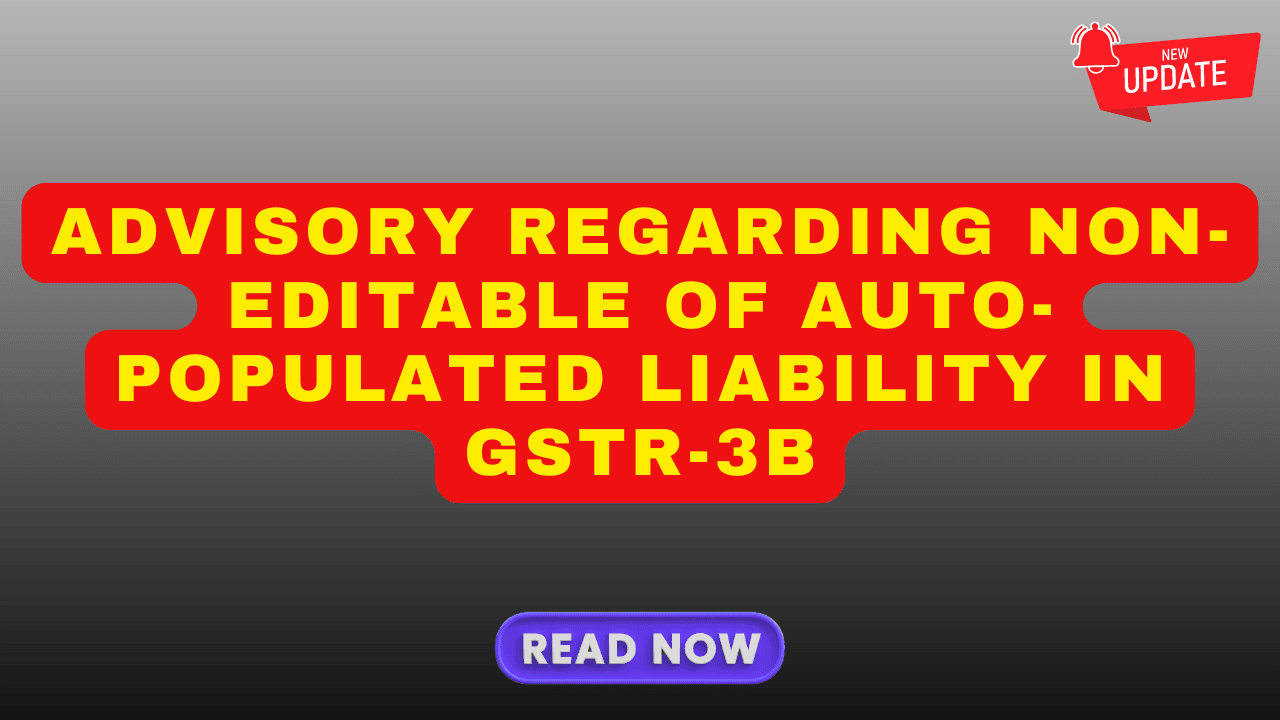GSTR-3B Auto-Populated Liability Will Soon Be Non-Editable: Here’s What You Must Know
Ravi’s Return Filing Rush: A Story Every Business Can Relate To
Ravi runs a small trading business in Delhi. Every month, like many GST-registered taxpayers, he files his GSTR-1 and GSTR-3B returns. But often, in a hurry or due to data mismatches, Ravi ends up declaring slightly different values in GSTR-3B compared to his GSTR-1.
“Don’t worry, I’ll adjust it manually in GSTR-3B,” he tells his accountant.
But things are about to change.
From July 2025 (returns filed in August 2025), taxpayers like Ravi will no longer be able to manually edit the auto-populated tax liability in GSTR-3B. Instead, any corrections must be done through Form GSTR-1A, introduced for this very reason.
Let’s break it all down in simple terms.
🧾 What Is GSTR-3B and How Does It Work?
GSTR-3B is a monthly summary return where you declare:
Outward supplies (sales)
Input Tax Credit (ITC)
Tax payable and paid
Until now, the GST portal auto-populates liability in GSTR-3B based on details filed in:
GSTR-1
IFF (Invoice Furnishing Facility)
But taxpayers still had the option to edit these figures in GSTR-3B before filing. That flexibility is now changing.
🆕 What’s the New Update from GSTN?
As per the latest advisory issued on June 7, 2025, here’s what’s changing:
🚫 From July 2025 Onwards:
Auto-populated liability in GSTR-3B will become non-editable.
This means whatever sales data you submit in GSTR-1/IFF (and amendments in GSTR-1A) will directly reflect in GSTR-3B.
You will no longer be able to manually reduce or modify the tax amount in GSTR-3B after it’s auto-filled.
🛠️ Role of Form GSTR-1A: Your New Amendment Tool
✅ What is GSTR-1A?
GSTR-1A is a new return introduced to allow amendments in outward supplies filed in GSTR-1/IFF within the same month before GSTR-3B is filed.
This gives taxpayers a chance to:
Correct mistakes in invoices or sales amounts
Update incorrect tax values
Adjust any discrepancies before liability gets locked in GSTR-3B
📌 Important Point:
You must file GSTR-1A before filing GSTR-3B to ensure the correct tax liability is reflected.
🧠 Why Is This Change Being Made?
The government and GSTN aim to:
Ensure better consistency between GSTR-1 and GSTR-3B
Reduce manual intervention and errors
Make GST returns more reliable and system-driven
Improve compliance monitoring and plug revenue leakages
📌 What Does It Mean for You as a Taxpayer?
This change affects every registered business filing monthly or quarterly returns.
🔍 Here’s what you need to know:
🔸 Carefully review your GSTR-1 before submitting.
🔸 If you notice an error or mismatch, file GSTR-1A immediately.
🔸 Do not wait till the last date — corrections must happen before filing GSTR-3B.
🔸 Coordinate with your accountant or tax consultant to avoid late fees or mismatches.
🔸 From August 2025, your GSTR-3B will be locked with system-generated values.
📅 Effective Timeline
| Action | Return Period | Filing Month |
|---|---|---|
| Start of non-editable auto-population | July 2025 | August 2025 |
| Use of Form GSTR-1A | Available from July 2025 | For corrections in the same tax period |
🔗 Other Relevant References
For deeper insights, taxpayers can also refer to:
📄 GSTN Advisory dated January 27, 2025
📄 GSTN Advisory dated October 17, 2024
These advisories explain how GSTR-1A works and how it supports reconciliation.
✅ How to Prepare for This Change
Here’s a quick checklist to stay compliant:
✔️ Do’s:
Reconcile books before filing GSTR-1
Double-check invoices, tax rates, and amounts
Use GSTR-1A immediately if any corrections are needed
File GSTR-3B only after reviewing final liability
❌ Don’ts:
Don’t rely on manual corrections in GSTR-3B anymore
Don’t file GSTR-3B first and correct GSTR-1 later
Don’t ignore mismatches — they may lead to notices or penalties
🧾 Conclusion: Accuracy is the New Priority
This move by GSTN is part of a larger shift toward automation and accuracy in GST compliance. While it may feel restrictive at first, it encourages businesses to maintain clean, consistent data and helps avoid disputes later.
With the introduction of GSTR-1A, taxpayers still have the flexibility to correct errors — just not at the final step. Think of it as checking your answers before submitting the paper, not correcting them after it’s submitted.
📘 Moral of the Story: File Smart, Not in Haste
Whether you’re like Ravi or run a larger enterprise, this update is your reminder:
“Double-check before you submit — because now, corrections will only happen upstream, not at the end.”
Stay informed, stay timely, and talk to your tax advisor early each month.

